Mastering a one-day shoot for your short film is all about planning and teamwork. Start by defining a clear concept; it’ll be your guiding star. Then, create a detailed script—think of it as your film’s treasure map! Gather a crew of enthusiastic friends; everyone needs a job to keep chaos at bay. Scout your locations ahead of time to avoid surprises, and plan your shooting schedule carefully, focusing on natural light. Don’t forget to choose lightweight equipment for easy moving. Most importantly, enjoy the process; it’s all part of your unique story. Ready to dive deeper into each step?
Key Highlights
- Define a clear and focused concept to shape your short film’s narrative and emotional impact.
- Create a detailed script that outlines scenes, actions, dialogue, and essential props for efficient shooting.
- Assemble a well-organized crew with clear roles to minimize chaos and enhance collaboration on shoot day.
- Scout locations in advance to assess lighting, space, and hazards, ensuring they align with your film’s vision.
- Optimize equipment choices by selecting lightweight, user-friendly gear for ease of movement and effective shooting.
Define Your Concept
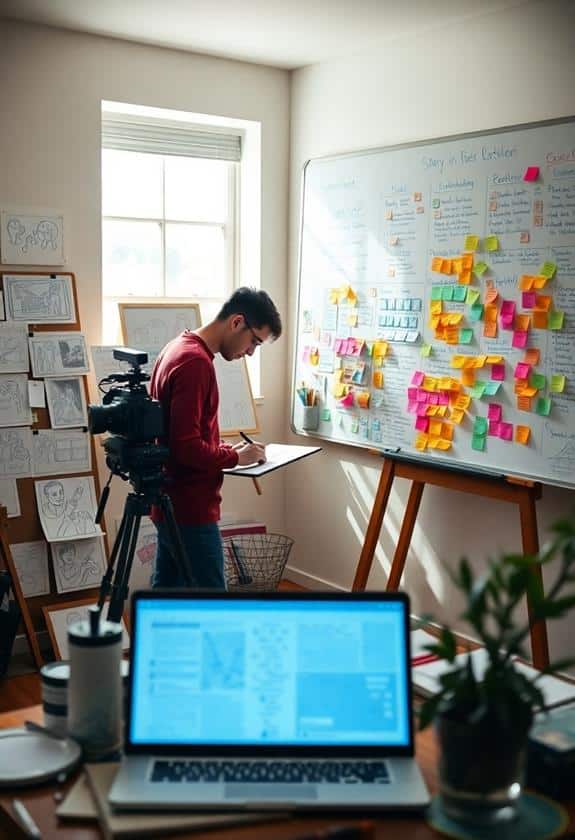
Defining your concept is the foundation of your short film, so don’t rush this essential step. Take a moment to think about what story you want to tell. You might have a wild idea bouncing around in your head, but it’s important to shape that idea into something clear and focused. Imagine you’re chatting with a friend—what’s the essence of your story? To keep your project organized, consider utilizing tools like acrylic clapboards to help structure your shoots and manage scene details.
Start by asking yourself some questions. What emotions do you want to evoke? Is it laughter, sadness, or maybe a bit of both? Once you pinpoint your feelings, think about the characters. Who are they? What challenges do they face?
I remember when I first started filming, I had this great concept but got lost in the details. I learned that simplifying my idea helped me stay on track and made it easier to shoot. It’s okay to make changes along the way, but having a solid concept will guide you through those tough moments on set.
Create a Detailed Script
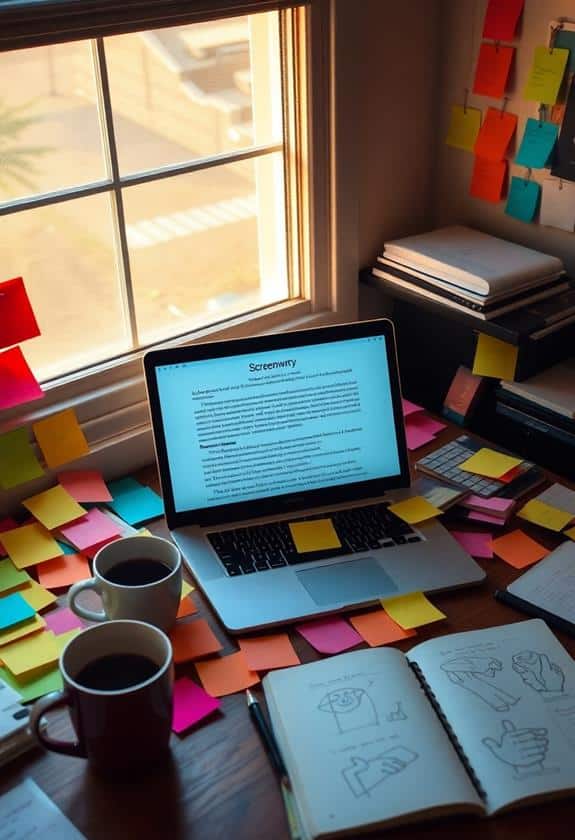
A detailed script is your roadmap for shooting a short film, and it’s vital to get it right. Think of it as a treasure map; without it, you’re likely to get lost! Start by outlining your story, breaking it down into scenes. Each scene should have clear action and dialogue that moves the plot forward. I remember my first attempt at scripting—I wrote pages of dialogue that sounded great in my head but felt clunky when I tried to film. Keep it simple and natural; your actors will thank you!
Additionally, consider how your script aligns with your choice of camera lenses to capture the right moments effectively. Next, include details about your settings and any important props. If a character needs a specific item, mention it in the script. This way, you won’t find yourself scrambling on shoot day, searching for a vital prop.
Don’t forget about timing! Note how long each scene should take to guarantee you can fit everything into your shooting schedule. Look, I’ve had days where I underestimated time, and it turned into a frantic rush. So, be realistic!
Lastly, make sure your script is easy to read. Use clear formatting, and maybe even add some fun notes for your crew. Happy scripting!
Assemble Your Crew
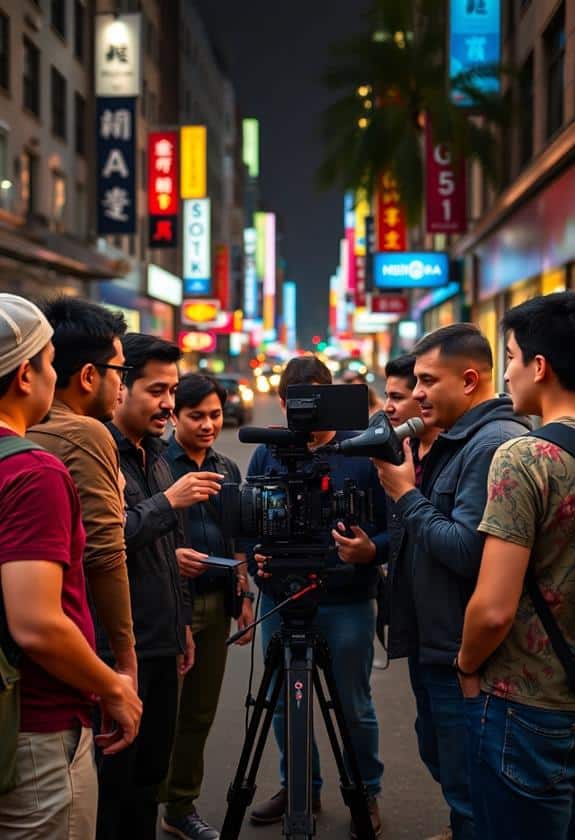
Once you’ve got your script locked down, it’s time to gather your team. Think of your crew as the backbone of your film; they’ll help bring your vision to life. Trust me, having the right people around you can make all the difference, especially when you’re racing against the clock.
Here’s a simple table to help you visualize who you might need:
| Role | Responsibilities | Suggested Experience |
|---|---|---|
| Director | Guides the creative vision | Previous short films |
| Cinematographer | Manages camera work | Knowledge of lighting |
| Sound Technician | Handles audio equipment | Background in sound design |
When you reach out, look for enthusiastic friends or classmates who are keen to learn. Safety is key, so make certain everyone’s on the same page about their roles and responsibilities. You don’t want chaos on shoot day! I remember my first film; someone tripped over a cable—yikes! A well-organized crew can help prevent those little mishaps.
Scout Locations in Advance
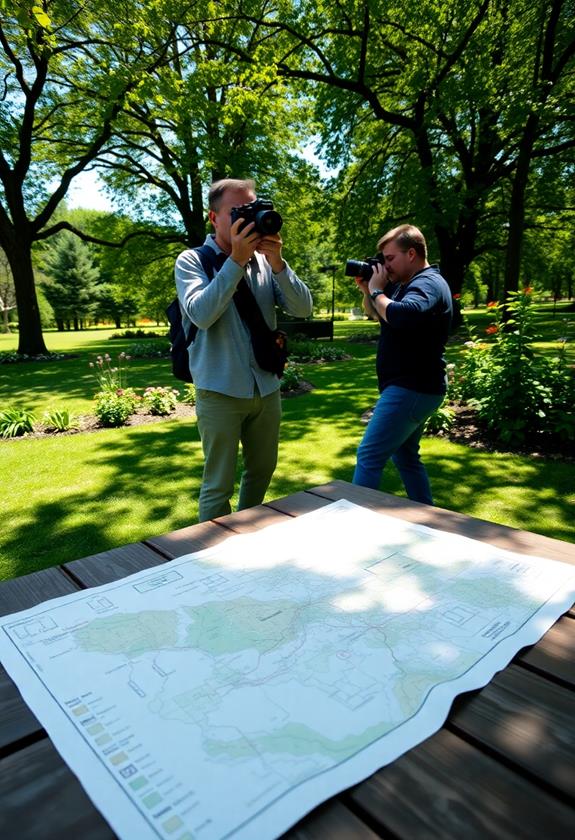
Before you plunge into shooting, it’s crucial to nail down your locations. Trust me, I’ve learned this the hard way! Imagine showing up to film, only to find the perfect park covered in construction barriers. Yikes! To avoid such a disaster, scout your locations in advance.
Start by making a list of spots that fit your film’s vibe. Is it a cozy diner or a spooky forest? Once you’ve got your list, visit each place and pay attention to lighting, space, and background noise. Make sure to also consider the accessibility of your equipment; a lightweight tripod, like the SENSYNE 62 Phone Tripod & Selfie Stick, can make a big difference when moving between locations. You want a location that not only looks good but feels safe for your crew.
Check for hazards like uneven ground or busy streets. Bring a friend along to help you assess the area—two pairs of eyes are better than one! If your location has public access, consider checking in with property owners or local authorities. It’ll save you headaches later on.
And don’t forget to take photos! Having reference images will help your crew visualize the scenes. Remember, a well-chosen location can elevate your short film, turning it from “meh” to “wow!” So get out there, explore, and have fun!
Plan Your Shooting Schedule
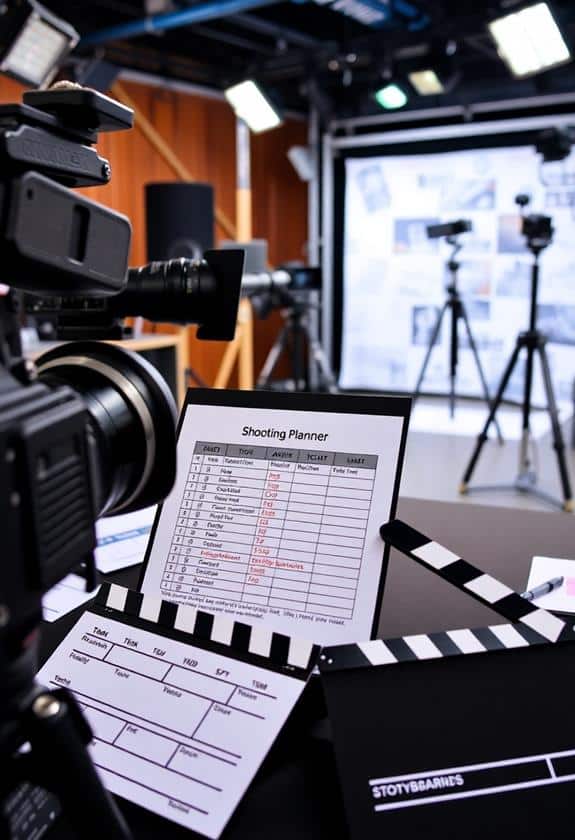
Having scouted your locations, it’s time to get organized and plan your shooting schedule. This step is essential, especially when you’ve only got one day. Start by breaking your script into manageable scenes and prioritize them based on location and lighting, as this can greatly impact your shoot’s overall quality. Trust me, it’s a lifesaver! Utilizing softbox lights for perfect lighting can help you achieve beautiful shots, even in challenging conditions.
You’ll want to estimate how long each scene will take, but don’t forget to include time for setup and breaks. Remember, a well-rested crew is a safe crew. When I shot my first short film, I learned the hard way that rushing leads to mistakes. We had a minor mishap with a light stand because we were in a hurry—yikes!
Consider the sun’s position, too. If you’re shooting outdoors, plan around the golden hour for that beautiful lighting. And don’t forget about safety! Make sure everyone knows the plan, and remind them to keep the set tidy to prevent accidents.
Optimize Equipment Choices
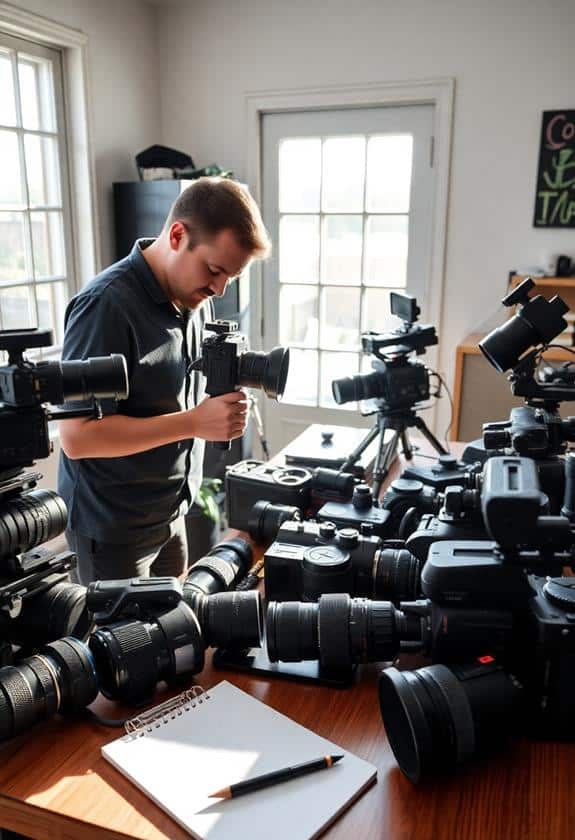
To make the most of your limited shooting time, optimizing your equipment choices is essential. You don’t want to be fumbling around with gear while your clock’s ticking! Choose equipment that’s lightweight yet effective, so you can easily move from one scene to another. Trust me, I’ve learned this the hard way—nothing slows you down like lugging around heavy gear. It’s also worth considering the best cameras for filmmakers that provide the right balance of features and portability to enhance your shooting experience.
Here are some tips for selecting your equipment:
- Camera: Pick a camera that’s user-friendly and has good low-light capabilities for those unexpected night scenes.
- Lenses: Bring versatile lenses, like a 24-70mm, to capture everything from wide shots to close-ups without switching constantly.
- Audio Gear: Don’t skimp on sound! A good shotgun mic can save your film. Clear audio is half the battle!
- Lighting: Use portable LED lights for flexibility. They’re easy to set up and can make a world of difference.
Focus on Post-Production Essentials
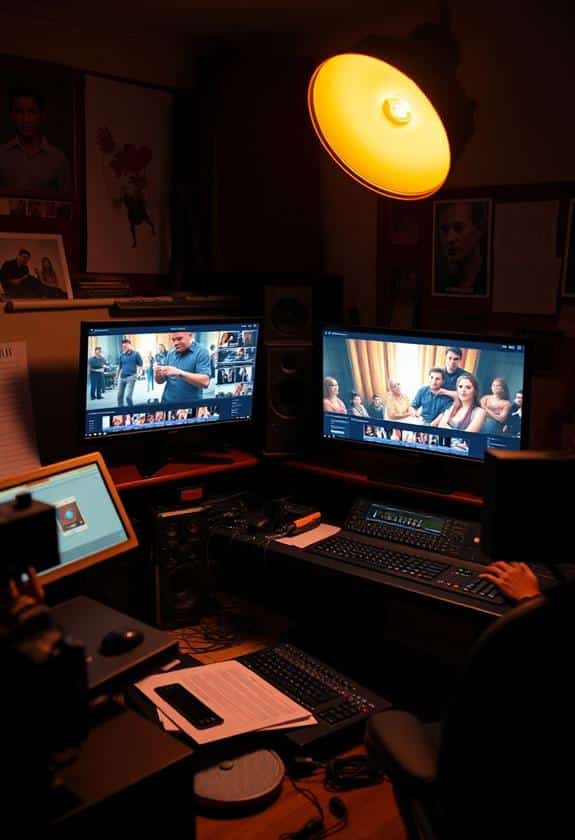
Post-production is where your short film truly comes to life, and focusing on the essentials can make all the difference. You’ve wrapped your shoot, and now it’s time to engage in editing, sound, and color correction. First, pick an editing software that feels right for you. I remember my first time using a program; it felt like a puzzle I didn’t know I could solve! Don’t be afraid to experiment and learn as you go.
Next, audio is vital. Poor sound can ruin even the best visuals. Invest in good quality microphones during filming, but also take time to clean up audio in post-production. You might need to adjust levels or add effects to make it sound just right.
Color correction is another key step. It can enhance the mood of your film. Play around with brightness, contrast, and saturation to find what fits your vision. Remember, it’s okay to ask for feedback from friends or mentors. They can offer fresh perspectives that you might miss.
Ultimately, enjoy the process! It’s a chance to put your stamp on the film and share your unique story with the world.
Frequently Asked Questions
How Do I Secure Permits for Filming in Public Locations?
Securing permits for filming in public locations can feel a bit overwhelming, but it’s totally manageable! Start by checking your local government’s website; they often have forms ready for you. Don’t forget to reach out to police or park services, too—they appreciate the heads-up! I once waited weeks for a permit, but it taught me patience. Just remember, safety first, and your film will shine bright! Happy shooting!
What Should I Do if It Rains on Shooting Day?
If it rains on shooting day, don’t panic! Grab some umbrellas and ponchos to keep everyone dry. Consider shooting scenes indoors or finding a cool covered spot for creative shots. Embrace the rain—wet streets can add a magical vibe to your film! If it gets too intense, take a break and enjoy some hot cocoa with your crew. Remember, every challenge can turn into a fun adventure; it’s all part of the filmmaking journey!
How Can I Handle Difficult Actors or Crew Members?
Dealing with difficult actors or crew members can be tough, but you’ve got this! First, try to listen and understand their concerns; sometimes, they just need to feel heard. If a conflict arises, keep your cool—yelling won’t help anyone! Share a funny story to lighten the mood. You might even find common ground. Remember, you’re all there for the same reason: to create something awesome together! Teamwork makes the dream work!
What Backup Plans Should I Have for Technical Failures?
When you’re shooting, technical failures can really throw you off. So, it’s smart to have backup plans! Keep extra batteries, chargers, and memory cards handy. If your camera fails, know someone nearby with a spare. Consider using your phone for quick shots if needed. And don’t forget to have a trusty plan B for sound—like a portable recorder. Trust me, being prepared takes a load off your mind and keeps the fun rolling!
How Do I Distribute My Short Film After Completion?
Once you finish your short film, it’s time to share it! Start by uploading it to platforms like YouTube or Vimeo. Don’t forget to promote it on social media—friends love supporting your work! You could even submit it to local film festivals; they’re great for exposure. And remember, asking for feedback is super helpful. It’s all about connecting with viewers, so keep those channels open and enjoy the journey!
Conclusion
So, there you have it! With a solid plan and a little creativity, you can turn your one-day shoot into something amazing. Did you know that about 80% of films are made on a budget of less than $250,000? It just goes to show that passion and teamwork can beat big bucks any day! I remember my first short film; we shot it in my friend’s backyard, and it turned out to be a blast. Now go make your film!




